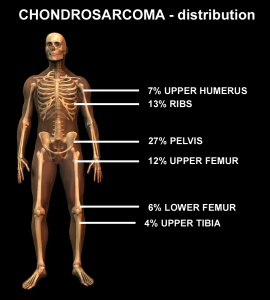Introduction
For one thing, a chondrosarcoma is a malignant tumor of the cartilage. Specifically, it tends to occur at the end of long bones and is most frequent in adults.
In general, about 10% develop in patients with multiple osteochondromas. It must be remembered that these are mushroom-like benign growths with a cartilage cap. One type, particularly, runs in families and has multiple such osteochondromas. They occur most often in teenagers between the ages of 10 and 20. About 10% of these will turn malignant in adult life (secondary chondrosarcomas). The other 90 % of chondrosarcomas are primary, meaning that they occur spontaneously in anybody.
Symptoms and tests
Certainly, bone pain at the area of the tumor is the first symptom. Explicitly, X-rays may not show anything as the tumor consists of cartilage and is invisible on plain X-rays. In contrast, CT and MRI scans, will depict the tumor. Notably, these tests cannot distinguish between benign osteochondroma and the malignant chondrosarcoma. Surely, only a bone biopsy will make the diagnosis. Another key point is that the surgeon will have to be extremely careful that cells are not breaking loose. This could contaminate the surrounding soft tissue as in the case of a chondrosarcoma this cancer will immediately form local metastases.
Treatment
In detail, there are 4 pathological grades from the slow growing grade I to the more rapidly growing grade IV. Another key point is that treatment consists of surgery where the entire tumor is removed. That is to say, if any tumor tissue is left behind, it will seed itself and regrow more of the mushroom-like cartilage tissue. To emphasize, without spillage of tumor during the surgery the cure rate is more than 50% , but it depends on the tumor grade. Both radiotherapy and chemotherapy will not show any benefit with this bone cancer. Recurrences will have to be treated more aggressively with surgery including amputation of the affected limb.
References
1. Cancer: Principles &Practice of Oncology. 4th edition. Edited by Vincent T. DeVita, Jr. et al. Lippincott, Philadelphia,PA, 1993. Chapter on Sarcomas of the soft tissues and bone.
2. Cancer: Principles&Practice of Oncology. 5th edition, volume 2. Edited by Vincent T. DeVita, Jr. et al. Lippincott-Raven Publ., Philadelphia,PA, 1997. Chapter on Sarcomas of the soft tissues and bone.
3. Conn’s Current Therapy 2004, 56th ed., Copyright © 2004 Elsevier
4. Ferri: Ferri’s Clinical Advisor: Instant Diagnosis and Treatment, 2004 ed., Copyright © 2004 Mosby, Inc
5. Suzanne Somers: “Breakthrough” Eight Steps to Wellness– Life-altering Secrets from Today’s Cutting-edge Doctors”, Crown Publishers, 2008







